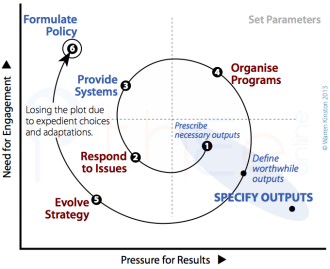
Cycle-2: Social Challenges
Cycle-1: Stage-1 to Stage-4 to Mode-1
Cycle-1 was about moving from asserting the need for simple obvious outputs, to self-consciously planning and organising for substantial achievement. As a successful project-entity inexorably grows, it starts to impact socially.
As a result, the social environment starts exerting countervailing pressures with little concern for whatever achievement is desired. These pressures generate additional challenges and new complexity, which is managed with the sophisticated modes of Cycle-2, starting with an awareness of the need for strategy.
Stage-5: Evolve Strategy

derived from .
Essence: Expanding organizations find themselves needing to handle interactions with their context. Entities here are diverse and autonomous: markets and competitors, communities, governments, other organizations, industry groups, employee and discipline-based associations, activist and social groups, the media, churches, &c.
Consequence: The environment is dynamic, often unpredictable, and not susceptible to management control. The only possibility is to maintain liaison, try persuasion, and generally adapt. The management skill is to continuously shape operations so as to ride social forces and co-evolve with the environment.
:
Pressure: The organization is now subject to a variety of challenges: often competitive, but also activist and political, regulatory and fiscal. It becomes easy to lose the plot. Staying the course adds a new degree of complexity related to values.

Stage-6: Formulate Policy
derived from .
Essence: In steering its operations through a social maze, all staff (many of whom will be labeled as managers) must be clear about what is most important and what the main goals are. So this must be formulated and communicated internally.
Consequence: The organization specifies its priorities and its strategic objectives i.e. the main outcomes desired for the entity as a whole. (Remember that outcomes and outputs are not the same.)
:
Pressure: The organization is now a powerful participant within the community, with a constant dedicated focus on its own values and goals. The issue is how that power will be used, and that raises the question of standards now visible in public. This ethical dimension adds a final quantum of complexity.

Stage-7: Control Identity
derived from .
Essence: The organization must be able to revise or renew its mission, and position itself appropriately in the social environment. This must be communicated externally so as to continuously attract and keep staff and customers (or clients or members or shareholders).
Consequence: The organization determines its own identity and recognizes its multiple responsibilities to the various stakeholders. Maintaining standards and balancing obligations in the face of temptations allows for maximum advantage.
Note: Outputs are no longer about what is prescribed on an intuitive obvious basis, or even what is defined and delivered within costed programs, but rather focus on what is maximum and feasible given determined well-organised and adequately-resourced initiatives. So there is a re-entry to further down the ellipse.

:
More? Any entity may get larger (if that makes sense), but there are no greater complexity challenges that can emerge, and no need for more sophistication in managing.
Q: Why have the names of the methods changed?
Q: Why can't a lower Stage of organisation handle a higher Stage method (e.g. have policies or set ethical standards)?
Q: Why can't there be other combinations e.g. when I specify outputs, why can't I simultaneously set parameters?
- The Stages show an oscillation in orientation between and . See diagram.
-
If you convert this to a hierarchy (as usual in THEE architecture), you will discover the , developed in detail in the next section.
OR
- Return to the Section Guide for other options.
Originally posted: 13-Dec-2013. Last updated: 17-Jan-2014